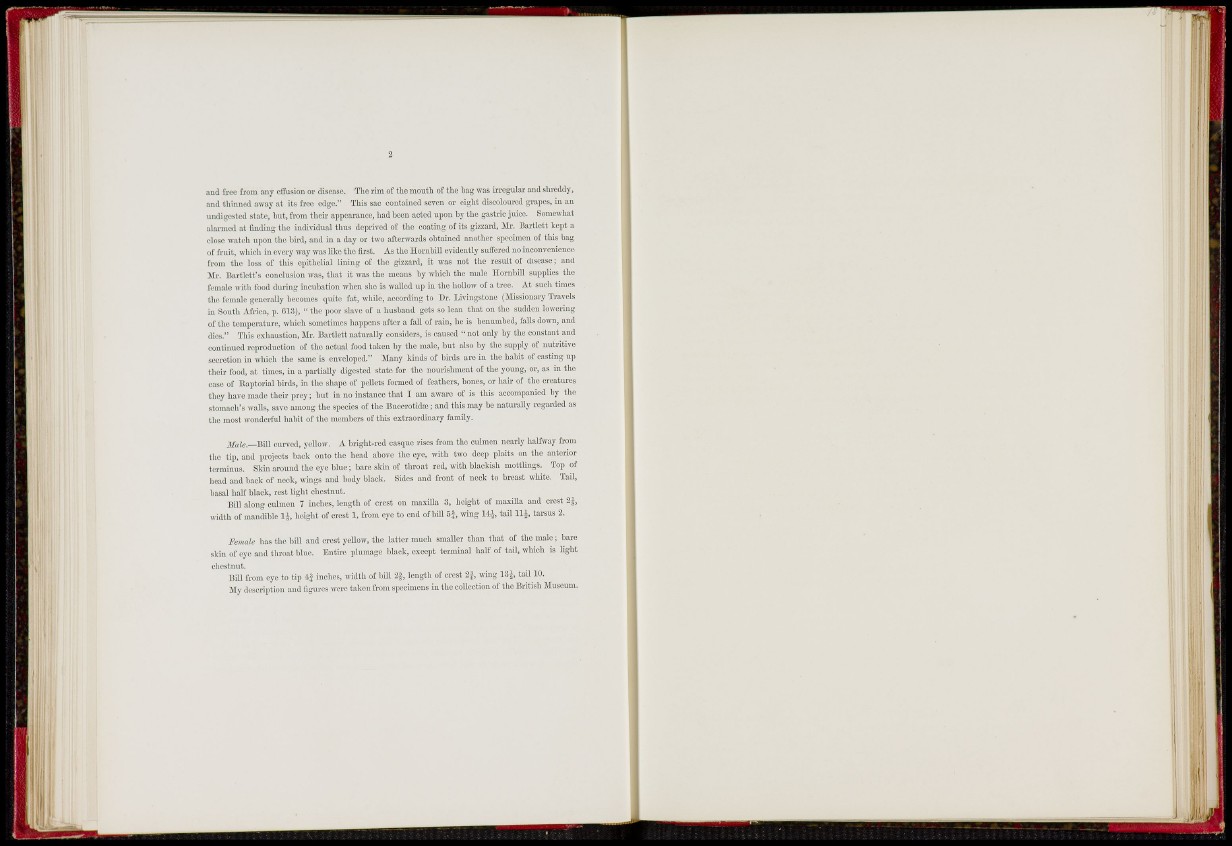
and free f rom any effusion or disease. The r im of the mout h of the hag was irregular and shreddy,
and thinned away at its free edge." This sac contained seren or eight discoloured grapes, in an
undigested state, but, from their appearance, had been acted upon by the gastric juice. Somewhat
alai-mcd at finding the individual thus deprived of the coating of its gizzard, Mr. Bartlett kept a
close watch upon the bird, and in a day or two afterwards obtained another specimen of this bag
of fruit, which in every way was like the first. As the Hornbill evidently sutfered no inconvenience
from the loss of this epithelial lining of the gizzard, it was not the result of disease; and
Mr. Bartlett's conclusion was, that it was the means by whicli the male lIorn\)ill supplies the
i'emale with food during incubation when she is walled up in the hollow of a tree. At such times
th(! female generally becomes quite fat, while, according to Dr. Livingstone (Missionai-y Travels
in South Africa, p. 013), " the poor slave of a husband gets so lean that on the sudden lowering
of the temperature, which sometimes happens after a fall of rain, he is benumbed, falls down, and
dies." This exhaustion, Mr. Bartlett naturally considers, is caused " not only by the constant and
continued reproduction of the actual food taken by the male, but also by the supply of nutritive
secretion in which the same is enveloped." Many kinds of birds are in tlie habit of easting up
their food, at times, in a partially digested state for the nourishment ol the young, or, as in the
ease of Raptorial birds, in the shape of pellets formed of feathers, bones, or hair of the creatures
they have made theb prey; but in no instance that I am aware of is this accompanied by the
stomach's walls, save among the species of the Bucerotidie; and this may be naturally regarded as
the most wonderful habi t of the members of this extraordinary family.
Male.—mi curved, yellow. A bright-red casque rises from the culmcn nearly halfway from
the tip, and projects back onto the head above the eye, with two deep plaits on the anterior
terminus. Skin around the eye blue; bare skin of throat red, with blackish mottlings. Top of
Ijead and back of neck, wings and body black. Sides and front of neck to breast white. Tail,
basal half black, rest light chestnut.
Bill along culmen 7 inches, length of crest on maxilla 3, height of maxilla and crest 2|,
width of mandible height of crest 1, from eye to end of bill 5f, wing Id.-^, tail 11^, tarsus 2.
Female has the bill and crcst yellow, the latter much smaller than that of the male ; bare
skin of eye and throat blue. Entire plumage black, cxcept terminal half of tail, which is light
chestnut.
Bill from eye to tip inches, width of bill 2f, length of crest 2| , whig 13i, tail 10.
J [ y description and figures were taken frojn specimens in the collection of the British Museum.